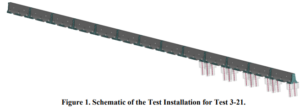| TTI Research Supervisor: Nauman M. Sheikh, P.E. Research Engineer Texas A&M Transportation Institute Texas A&M University System TAMU 3135, College Station, Texas,77843-3135 (979) 317-2695 [email protected] |
Pooled Fund Technical Representative: Bob Meline, P.E. California Department of Transportation Structural Materials Building, Rm 422 5900 Folsom Blvd. Sacramento, CA 95819 (916) 227-7031 [email protected] |
 Four of the barrier segments will be anchored on an asphalt pavement in a median configuration, i.e., each segment will be anchored with four anchoring pins – one installed in each corner of the barrier segment. The transition barrier segment will be the same F-shape barrier segment as the rest of the system. This segment, however, will only be anchored using two anchoring pins – one installed in each corner hole directly adjacent to the anchored PCB system. There will be 8 freestanding/unanchored segments that will be attached to the transition barrier segment. The asphalt pad underneath the anchored PCB segments will be 4 inches thick and will be constructed on top of compacted soil. After the crash test has been performed, the research team will demolish the test installation, dispose the PCB barriers and associated hardware, and restore the test site to original conditions.
Four of the barrier segments will be anchored on an asphalt pavement in a median configuration, i.e., each segment will be anchored with four anchoring pins – one installed in each corner of the barrier segment. The transition barrier segment will be the same F-shape barrier segment as the rest of the system. This segment, however, will only be anchored using two anchoring pins – one installed in each corner hole directly adjacent to the anchored PCB system. There will be 8 freestanding/unanchored segments that will be attached to the transition barrier segment. The asphalt pad underneath the anchored PCB segments will be 4 inches thick and will be constructed on top of compacted soil. After the crash test has been performed, the research team will demolish the test installation, dispose the PCB barriers and associated hardware, and restore the test site to original conditions. 